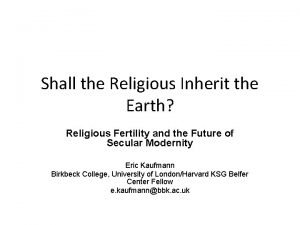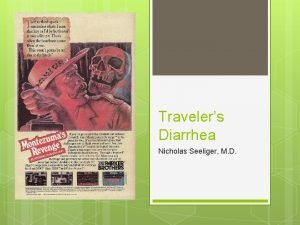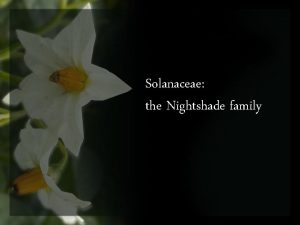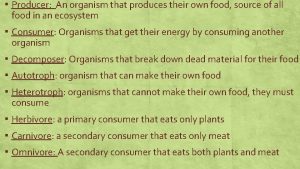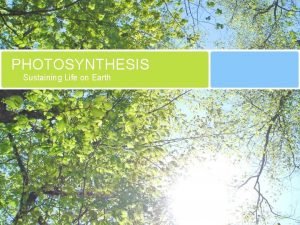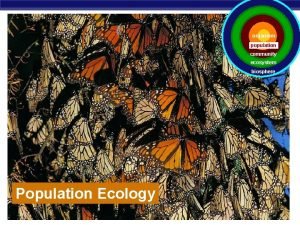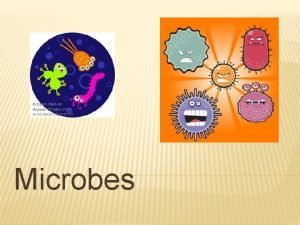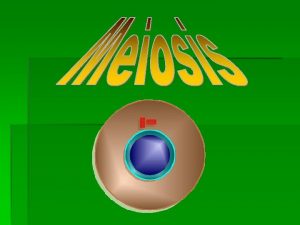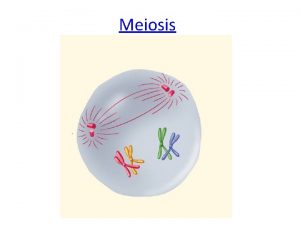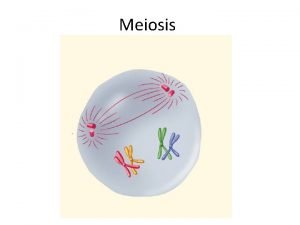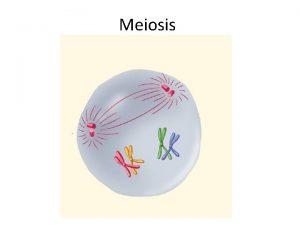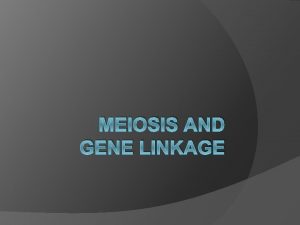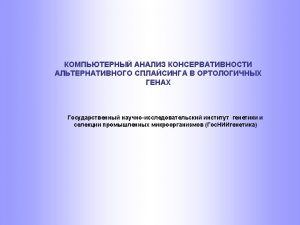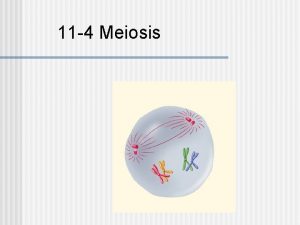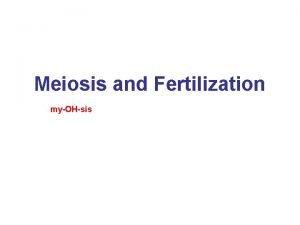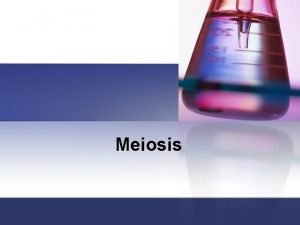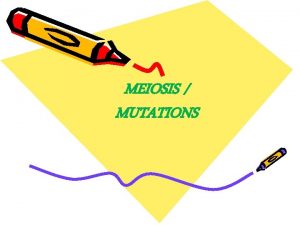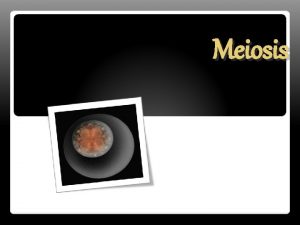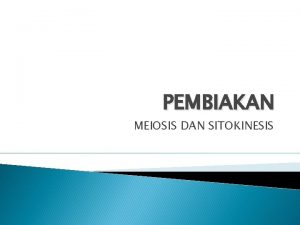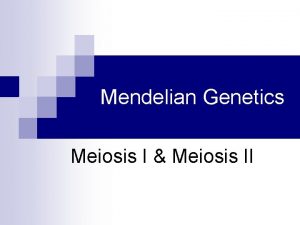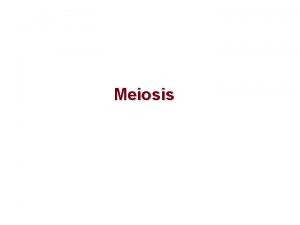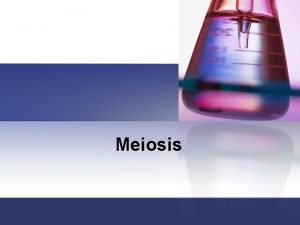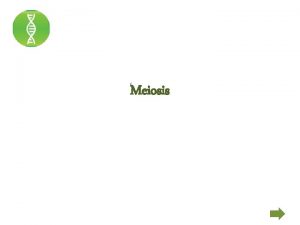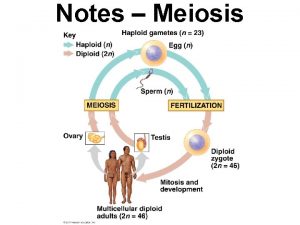Meiosis An Introduction An organism must inherit a


























- Slides: 26


Meiosis: An Introduction § An organism must inherit a single copy of every gene from its parents. § Meiosis is a process in which the number of chromosomes per cell is cut in half through the separation of homologous chromosomes in a diploid cell.

Chromosome Number § Different organisms have different numbers of chromosomes. § Humans have 46 chromosomes, 22 pairs of autosomes and one pair of sex chromosomes. § A pair (or set) of chromosmes (one from each parent) are called “homologous”

The “Diploid” Condition § A cell that contains both sets of homologous chromosomes is said to be diploid. § The number of chromosomes in a diploid cell is sometimes represented by the symbol 2 N. § For humans, the diploid number is 46, which can be written as 2 N=46. Diploid

The “Haploid” Condition § Meiosis results in the production of haploid gametes (sex cells) which have only 23 chromosomes. § Meiosis involves two divisions, meiosis I and meiosis II. § By the end of meiosis II, the diploid cell that entered meiosis has become 4 haploid cells (N).


Meiosis I § Interphase I is essentially identical to the process previously outlined in the somatic cell cycle. § Cells undergo a round of DNA replication, forming duplicate chromosomes. Interphase I

Meiosis I: Prophase I § During Prophase I each chromosome pairs with its corresponding homologous chromosome to form a tetrad. Prophase I § There are 4 chromatids in a tetrad. Tetrad

Meiosis I: Synapsis §Tetrads formed during Prophase I exchange portions of their chromatids in a process called crossing over. §Crossing-over produces new allele combinations and is a key source of variation in multicellular organisms. Tetrad Allele Chromatid

Meiosis I: Metaphase I How is this different from Mitosis? § During Metaphase I, the 23 homologous pairs (tetrads) line up along the equator of the cell. § The assortment of these chromosomes is independent, a primary source of variation within a species.

Alignment at metaphase I or combinations possible Possible Chromosome Combinations or or Independent Assortment at Metaphase I

Meiosis I: Anaphase I § During Anaphase I the homologous pairs separate (via shortening spindle fibers) and move toward the poles of the cell. § Note the difference from mitosis; while the homologous pairs have left one another, the chromatids are still in tact at the centromere. Anaphase I

Meiosis: Telophase I and Cytokinesis § Nuclear membranes form and the spindle breaks down. § Cleavage results in two cells. § The two haploid (N) cells produced by meiosis I have chromosomes from each homologous pair. • The cells are different from each other (remember independent assortment) and from the diploid cell that entered meiosis I.

Meiosis II The 2 haploid cells produced by meiosis I now enter a second meiotic division which results in the production of 4 genetically different haploid cells. No replication takes place. Remember, the chromosomes already replicated during Interphase I.

§Meiosis II Telophase II and Cytokinesis II Telophase I and Cytokinesis I Prophase II Metaphase II Anaphase II

Meiosis II § During Prophase II, each of the cell’s 23 chromosomes has 2 chromatids. § Spindle fibers reform and move chromosomes toward cell equator.

Meiosis II • During Metaphase II Chromosomes move to midline of dividing cell, facing opposite poles.

Meiosis II • During Anaphase II, chromatids separate and move toward opposite poles of the cell.

Meiosis II § During Telophase II, the nuclear membrane reforms around chromosomes in each of the four new cells, and a second round of cytokinesis produces four new haploid cells

Sperm or Ovum

Gamete Development… § Spermatogenesis: four new cells from meiosis called spermatids in males develop into mature sperm cells

Gamete Development (cont. ) § Oogenesis: During cytokinesis following meiosis in females, cytoplasm is divided unequally among the four new cells. § One cell receives most of the original cell’s cytoplasm and develops into a mature egg called an ovum. The other three cells called polar bodies die off.

Gamete Development (cont. )

Sexual Reproduction § When the nuclei of the two gametes combine during fertilization, the 2 n number is restored (2 n = 46). § The fusion of two gametes produces the first cell of the new animal called a zygote.

“I want one of my haploid gametes to fertilize one of your haploid gametes…” “OMG! A zygote? . . . How romantic!”

That’s All Folks!
 Food chain
Food chain Similarities and differences between parents and offspring
Similarities and differences between parents and offspring Star spangled eyes meaning
Star spangled eyes meaning Shall the religious inherit the earth
Shall the religious inherit the earth He who overcomes will inherit all things
He who overcomes will inherit all things Blessed are the meek for they shall inherit the earth
Blessed are the meek for they shall inherit the earth The weak shall inherit the gym answers
The weak shall inherit the gym answers Meiosis i vs meiosis ii
Meiosis i vs meiosis ii Meiosis and mitosis
Meiosis and mitosis Crossing over occurs during:
Crossing over occurs during: What is the difference between mitosis and meiosis 2
What is the difference between mitosis and meiosis 2 Chapter 10 section 1: meiosis
Chapter 10 section 1: meiosis Chapter 10 meiosis 1 and meiosis 2 answer key
Chapter 10 meiosis 1 and meiosis 2 answer key Where does meiosis occur
Where does meiosis occur He must become greater; i must become less
He must become greater; i must become less Unicellular fungi examples
Unicellular fungi examples Are birds unicellular or multicellular
Are birds unicellular or multicellular Organism
Organism Nicholas seeliger, md flpen panama city beach
Nicholas seeliger, md flpen panama city beach Transgenic organism
Transgenic organism Family solanaceae classification
Family solanaceae classification Organism producer
Organism producer Name the picture
Name the picture Biology taxonomy
Biology taxonomy What is a photosynthetic organism
What is a photosynthetic organism Exponential growth rate formula biology
Exponential growth rate formula biology Microscopic organism definition
Microscopic organism definition



